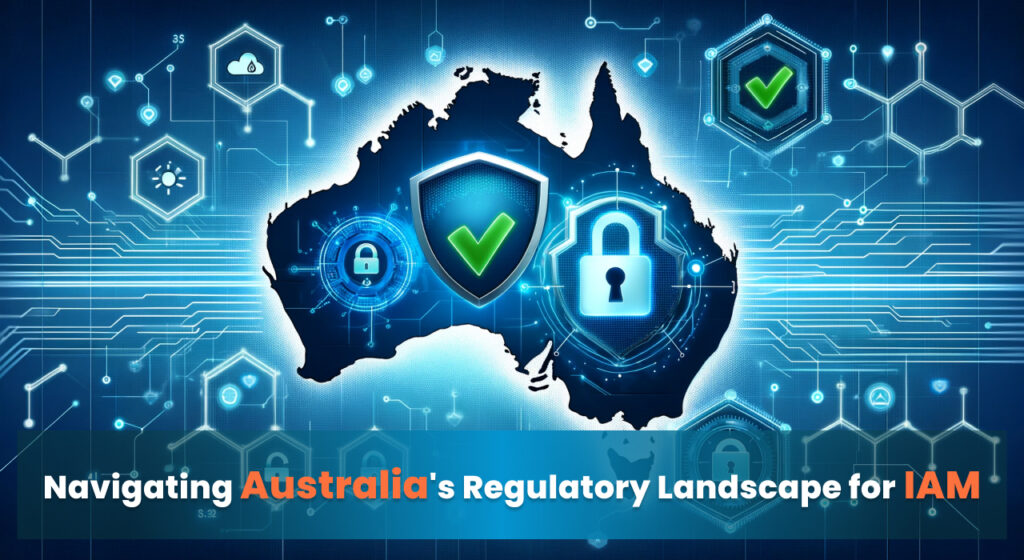
dentity and Access Management (IAM) is a critical component of modern organisational security frameworks, providing a structured approach to managing digital identities and access privileges. In Australia, the effective implementation of IAM is paramount due to the stringent regulatory environment and the increasing incidence of cyber threats. According to the Australian Cyber Security Centre (ACSC), there were over 67,500 cybercrime reports in the 2020-2021 financial year, highlighting the urgent need for robust security measures.
Regulatory compliance plays a crucial role in ensuring that businesses protect sensitive information and maintain trust with their stakeholders. Australian laws, such as the Australian Privacy Principles (APPs) and the Notifiable Data Breaches (NDB) scheme, mandate strict guidelines on data protection and user privacy. Non-compliance can result in significant penalties, legal repercussions, and reputational damage.
IAM solutions not only help organisations meet these regulatory requirements but also enhance operational efficiency by automating identity verification and access control processes. In an era where data breaches and cyber-attacks are prevalent, IAM serves as a foundational element in safeguarding organisational assets and ensuring business continuity. Therefore, understanding and navigating the regulatory landscape of IAM in Australia is essential for businesses striving to protect their digital ecosystems.
Overview of Australian Regulatory Environment

The regulatory landscape for Identity and Access Management (IAM) in Australia is shaped by a comprehensive framework of laws and guidelines designed to protect personal data and ensure privacy. Key regulatory bodies and legislation play pivotal roles in enforcing compliance and safeguarding information security.
The Australian Privacy Principles (APPs), established under the Privacy Act 1988, are fundamental to the country’s privacy regulation. These principles outline the obligations of entities in handling personal information, including its collection, use, disclosure, and management. They mandate that organisations implement reasonable steps to protect personal data from misuse, interference, and loss, as well as unauthorised access, modification, or disclosure. Compliance with the APPs is essential for businesses to maintain the privacy and trust of individuals.
The Notifiable Data Breaches (NDB) scheme, introduced in 2018, is another critical element of Australia’s regulatory framework. The NDB scheme mandates that organisations inform both the affected individuals and the Office of the Australian Information Commissioner (OAIC) when a data breach is expected to cause significant harm. This notification must include recommendations for steps individuals should take in response to the breach. The NDB scheme aims to enhance transparency and accountability, ensuring that organisations respond promptly and effectively to data breaches.
In addition to the APPs and NDB scheme, other relevant legislation includes the Telecommunications and Other Legislation Amendment (Assistance and Access) Act 2018, which grants law enforcement agencies access to encrypted communications, and the Security of Critical Infrastructure Act 2018, which imposes obligations on owners and operators of critical infrastructure to safeguard against cyber threats.
The OAIC is the principal regulatory body overseeing privacy and data protection in Australia. It provides guidance, investigates complaints, and enforces compliance with privacy laws. Other key bodies include the Australian Cyber Security Centre (ACSC), which offers cybersecurity advice and support, and the Australian Communications and Media Authority (ACMA), which regulates telecommunications and broadcasting.
Understanding these regulatory elements and the roles of these bodies is essential for businesses to navigate the complexities of IAM compliance in Australia. This regulatory environment ensures that organisations are held accountable for protecting personal information and maintaining robust security practices.
For more detailed information, visit the Office of the Australian Information Commissioner (OAIC) and other relevant regulatory bodies.
Key Compliance Requirements for IAM

Compliance with Identity and Access Management (IAM) regulations in Australia necessitates adherence to several specific requirements that ensure the security and privacy of personal information. These requirements, embedded in various laws and guidelines, mandate robust mechanisms for user authentication, data protection, and privacy policies.
User Authentication
One of the fundamental compliance requirements is the implementation of strong user authentication protocols. This involves verifying the identity of users accessing systems and data through multi-factor authentication (MFA) methods. MFA significantly reduces the risk of unauthorised access by requiring two or more verification factors, such as something the user knows (password), something the user has (security token), or something the user is (biometric verification). Organisations must ensure that these authentication methods are secure and regularly updated to combat evolving threats.
Data Protection
Australian laws, particularly the Australian Privacy Principles (APPs), impose stringent data protection obligations on organisations. These include the secure handling, storage, and disposal of personal information. Entities must implement measures to protect data from misuse, interference, loss, and unauthorised access, modification, or disclosure. Encryption, access controls, and regular security audits are critical practices that help meet these requirements. Additionally, organisations must conduct risk assessments to identify and mitigate potential vulnerabilities in their data protection strategies.
Privacy Policies
Compliance also involves the formulation and maintenance of comprehensive privacy policies. These policies must clearly outline how personal information is collected, used, disclosed, and managed. Under the APPs, entities are required to ensure that their privacy policies are easily accessible and regularly updated to reflect any changes in practices or legislation. Transparency in privacy policies fosters trust with individuals and demonstrates a commitment to protecting their personal information.
Impact on Businesses
The compliance requirements for IAM have significant implications for businesses. Meeting these standards often necessitates substantial investments in technology and human resources. Implementing advanced authentication mechanisms, such as MFA, can incur costs related to hardware, software, and ongoing maintenance. Similarly, robust data protection measures require continuous monitoring and updating of security systems to address new threats.n.
Non-compliance can lead to severe consequences, including financial penalties, legal actions, and reputational damage. For instance, the Office of the Australian Information Commissioner (OAIC) has the authority to impose significant fines on organisations that fail to comply with privacy laws. Additionally, breaches of data protection requirements can erode consumer trust and result in loss of business.
Conversely, adhering to IAM compliance requirements can provide competitive advantages. Businesses that demonstrate a commitment to data security and privacy can enhance their reputation and build stronger relationships with customers. Moreover, compliance with IAM standards can streamline operations, reduce the risk of data breaches, and ensure business continuity.
| Compliance Requirement | Implications |
|---|---|
| User Authentication | Implementing Multi-Factor Authentication (MFA); Regularly updating authentication methods to combat evolving threats. |
| Data Protection | Ensuring secure handling, storage, and disposal of data; Conducting regular security audits. |
| Privacy Policies | Formulating transparent privacy policies; Keeping policies up-to-date and easily accessible. |
| Risk of Non-Compliance | Financial penalties, legal actions, reputational damage, loss of consumer trust. |
| Benefits of Compliance | Enhanced reputation, competitive advantage, reduced risk of data breaches, ensured business continuity. |
Challenges in Navigating Compliance

Complying with Identity and Access Management (IAM) regulations presents numerous challenges for businesses in Australia. One of the primary difficulties is keeping up with the rapidly evolving regulatory landscape. Legislation and guidelines related to data protection and privacy are frequently updated to address new security threats and technological advancements. Organisations must remain vigilant and continuously monitor regulatory changes to ensure ongoing compliance. This necessitates dedicated resources and expertise, which can be particularly burdensome for small and medium-sized enterprises.
Integrating IAM systems effectively poses another significant challenge. Many businesses operate with legacy systems that are not inherently designed to meet modern IAM requirements. The integration of new IAM solutions with existing infrastructure can be complex and costly. This process often involves substantial technical modifications and may require specialised knowledge to avoid disruptions to business operations. Additionally, ensuring that these systems are scalable and adaptable to future regulatory changes adds another layer of complexity.
Managing user access securely is a further challenge that businesses must navigate. As organisations grow, the number of users and the complexity of access requirements increase. Implementing robust user authentication methods, such as multi-factor authentication (MFA), is essential but can be met with resistance from users due to perceived inconvenience. Balancing security with user experience is crucial to achieving compliance without compromising operational efficiency.
Moreover, businesses must address the human factor in IAM compliance. Employees need to be adequately trained on security policies and practices to prevent unauthorised access and data breaches. Ensuring consistent adherence to these practices across the organisation requires ongoing education and awareness programs, which can be resource-intensive.
The financial implications of IAM compliance are also a notable challenge. Investing in advanced IAM technologies, regular security audits, and continuous staff training can be costly. For businesses operating on tight budgets, allocating sufficient funds to meet these compliance requirements can be a significant hurdle.
Finally, non-compliance with IAM regulations can result in severe penalties, legal actions, and reputational damage. The threat of these consequences adds pressure on businesses to maintain high compliance standards, which can be stressful and demanding.
Navigating the complexities of IAM compliance requires a strategic approach that balances regulatory requirements with practical business considerations. By understanding and addressing these challenges, organisations can better position themselves to protect their assets and maintain compliance.
Best Practices for IAM Compliance

Ensuring compliance with Identity and Access Management (IAM) regulations requires adopting several best practices tailored to the Australian regulatory landscape. These practices not only help organisations meet legal requirements but also enhance overall security.
Regular Audits
Conducting regular audits is essential for maintaining IAM compliance. Audits help identify potential vulnerabilities and ensure that security measures are effective and up-to-date. Organisations should schedule periodic internal and external audits to review their IAM policies, procedures, and systems.
Employee Training
Continuous employee training is crucial for fostering a security-conscious culture. Training programs should educate staff on the importance of IAM, the specifics of compliance requirements, and best practices for protecting sensitive information. Regular training sessions and updates on the latest security threats and regulatory changes can significantly reduce the risk of human error.
Robust IAM Solutions
Implementing advanced IAM solutions is fundamental for achieving compliance. Organisations should invest in technologies that provide multi-factor authentication (MFA), role-based access control (RBAC), and automated provisioning and de-provisioning of user accounts. These solutions not only enhance security but also streamline access management processes.
By adhering to these best practices, organisations can effectively navigate the complexities of IAM compliance, protect sensitive data, and maintain the trust of their stakeholders. For more detailed guidance, refer to best practices guides and expert opinions from reputable sources in the cybersecurity field.
Case Studies: Successful IAM Compliance

Case Study 1: XYZ Financial Services
XYZ Financial Services, a mid-sized Australian firm, faced significant challenges in complying with IAM regulations due to its complex IT infrastructure and large customer base. The company implemented a comprehensive IAM solution that included multi-factor authentication (MFA) and role-based access control (RBAC). Regular audits were conducted to ensure compliance with the Australian Privacy Principles (APPs) and the Notifiable Data Breaches (NDB) scheme. By investing in employee training programs, XYZ Financial Services enhanced staff awareness of security protocols. As a result, the company not only achieved compliance but also reported a 40% reduction in security incidents over 12 months, demonstrating the effectiveness of its IAM strategy.

Case Study 2: ABC Healthcare
ABC Healthcare, a leading provider of medical services, prioritised IAM compliance to protect sensitive patient information. The organisation adopted a robust IAM framework that integrated automated user provisioning and de-provisioning, ensuring that only authorised personnel had access to critical systems and data. ABC Healthcare also developed a transparent privacy policy in line with the APPs, enhancing patient trust. The implementation of regular training sessions for employees on IAM best practices further strengthened their compliance efforts. This proactive approach resulted in ABC Healthcare receiving commendation from the Office of the Australian Information Commissioner (OAIC) for its exemplary data protection measures, setting a benchmark for the industry.
These case studies illustrate how strategic IAM implementation and ongoing commitment to compliance can lead to significant security improvements and regulatory adherence. For detailed reports and further insights, refer to the respective business publications and compliance documentation.
Conclusion and Future Outlook
The importance of Identity and Access Management (IAM) compliance cannot be overstated in the context of Australia’s stringent regulatory environment. Effective IAM practices not only ensure adherence to laws such as the Australian Privacy Principles (APPs) and the Notifiable Data Breaches (NDB) scheme but also protect organisations from potential security breaches and the consequent financial and reputational harm. By implementing robust IAM solutions, conducting regular audits, and fostering a culture of security awareness through continuous employee training, businesses can achieve and maintain compliance while safeguarding their digital assets.
Looking forward, the landscape of IAM regulations in Australia is expected to evolve in response to emerging security threats and technological advancements. Future regulations are likely to place greater emphasis on advanced authentication methods, enhanced data protection measures, and more stringent reporting requirements for data breaches. Organisations will need to stay abreast of these changes and adapt their IAM strategies accordingly to ensure ongoing compliance.
Furthermore, the integration of artificial intelligence (AI) and machine learning (ML) technologies into IAM solutions is anticipated to play a significant role in the future. These technologies can provide predictive analytics, automate routine security tasks, and identify potential threats in real time, thereby enhancing the overall effectiveness of IAM systems.
In conclusion, maintaining IAM compliance is essential for protecting sensitive information and ensuring business continuity in an increasingly complex regulatory landscape. By staying informed of regulatory updates and leveraging innovative technologies, Australian businesses can navigate the future of IAM with confidence and resilience. For the latest trends and regulatory updates, refer to forecast reports and authoritative sources in the field of cybersecurity and data protection.
